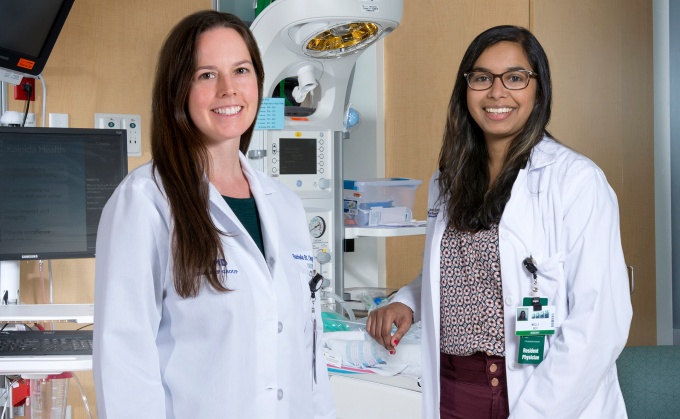
Resident Molly Roy, MD, right, works with faculty member Rachelle M. St. Onge, MD, during her rotations at Millard Fillmore Suburban Hospital and Oishei Children’s Hospital.
PGY-4
In the last year of your residency, you will function independently and complete the development of your clinical and surgical skills to become a specialist in obstetrics and gynecology.
Clinical Program
| Name of Rotation | Length of Rotation |
|---|---|
| Obstetrics | 5 modules |
| Gynecology | 8 modules |
| Continuity Clinic | One half-day per week |
In your final year of residency, you will serve as primary surgeon on all obstetric and gynecologic surgeries.
At this stage of your training, you will be expected to function independently, and in conjunction with your attending physician, serve as a leader on your clinical services.
You are also responsible for the administrative assignments of residents, in consultation with the clinical chief at a particular site.
You will be responsible for supervising and training junior residents and medical students, including coordinating concurrent study series at assigned sites and directing medical student and junior resident teaching.
While on a given rotation, the chief resident takes the lead in resident activities and is responsible for assigning clinical responsibilities to junior residents and students.
Didactic Curriculum
Lectures and training experiences vary from week to week, but may include basic lectures in obstetrics and gynecology, quality assurance and quality improvement presentations, research lectures, pathology conferences, neonatal conferences, journal clubs, Council on Resident Education in Obstetrics and Gynecology (CREOG) reviews and various clinical workshops.
You will participate in simulation experiences for obstetrics emergencies, hysteroscopy and laparoscopy labs and an anatomy laboratory featuring cadaver dissection.
You are expected to actively participate in all experiences and will be scheduled to present at the quality improvement/quality assurance case presentations and to select the articles for one of the monthly journal clubs.
Teaching Medical Students
You will interact with and teach third- and fourth-year medical students throughout this rotation and serve as a preceptor for small-group learning. You may also teach in the didactic curriculum for third-year clerks.